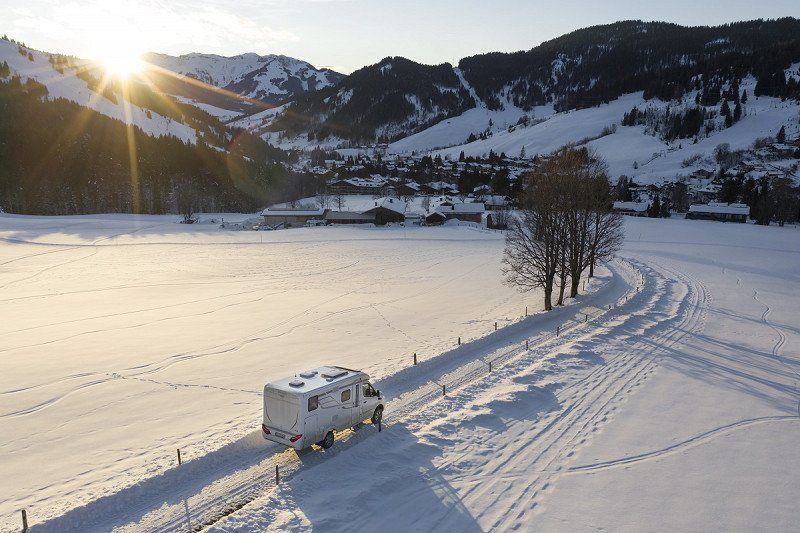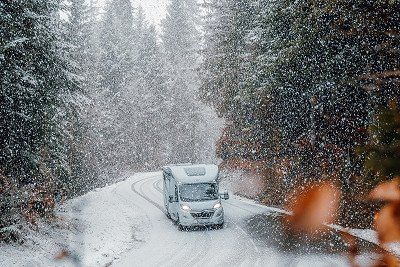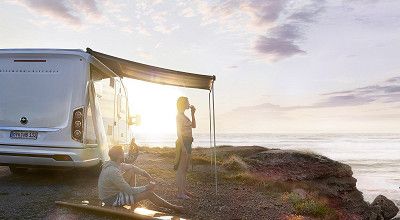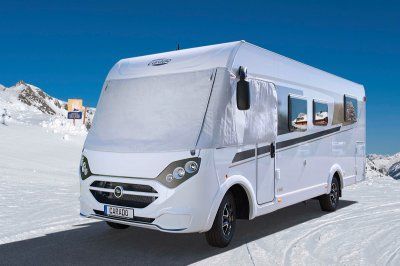Latest update: November 10, 2023
More and more motorhome owners discover the joy of winter camping and want to use their vehicles in the cold season as well. But which motorhomes and camper vans are actually suitable for use in winter, what should you pay attention to before buying and which accessories are useful in winter? Freeontour has summarized the most important points about motorhomes that are fit for winter use.
Which motorhomes and camper vans are suitable for winter?
A lot of the manufacturers of motorhomes and campervans based in Europe have recognized the trend towards winter camping and have been offering appropriately equipped vehicles for many years. This applies, for example, to all motorhomes and camper vans from the Erwin Hymer Group brands, all of which have been winter-proofed and thus are suitable for winter camping. You can be sure of this, because product development for all these brands includes an extensive endurance test in the cold chamber and subsequent optimization of the vehicles for the special conditions in the cold season. During the test in the cold chamber, the interior of the vehicle is cooled down to at least 0°C over several hours. The heating must then be able to reach an internal temperature of 20°C within two hours. An infrastructure that has been thoroughly checked in this way is essential on a winter holiday, since it might be noted as annoying if the heating does not work properly in spring or autumn. In winter it would mean that the holiday very suddenly is at an end.
Is there a difference between winterised motorhomes and winter-proof motorhomes?
When it comes to the equipment and performance of a motorhome or campervan in winter, the difference between winter-proof and winterised in Europe is clearly defined in accordance with specific standards, in Germany for example it's the DIN standard EN 1646-1. All motorhomes and camper vans that pass the test procedure described above and can be heated from 0°C to an internal temperature of 20°C within two hours are according to this standard winter-proofed and thus suitable for winter. A centrally placed measuring point in the middle of the living area of the vehicle is the decisive factor. In addition, at least five other measuring points in the vehicle are not allowed to show a difference of more than 7°C.
Motorhomes and camper vans that may be definded as winterised go one step further: For winter-proofed motorhomes only the heating behavior is measured. For winterised motorhomes, however, the stabilization time or insulation as well as the water system are also examined carefully. In addition, a winterised vehicle must be able to withstand significantly lower temperatures. For this test, the motorhomes are cooled down to -15°C for at least ten hours. The heating system then has to be able to heat the interior to 20°C within four hours. In addition, it is checked whether the vehicle can keep this temperature over a longer period and whether all water pipes and systems function properly even in the cold and do not freeze.
Should only vehicles from the premium segment be considered for winter camping?
All motorhomes and camper vans that pass the test for winter-proofed vehicles are also suitable for winter camping. As mentioned above, this applies to all motorhomes and camper vans from the Erwin Hymer Group brands - regardless of the price range. In the Sunlight models in the entry-level category, for example, the built-in Styrodur material ensures solid insulation in both the motorhomes and the campervans. These models are particularly popular with younger winter sports enthusiasts, especially since they weigh less than 3.5 tons and can be driven with a class B driving license. Those who wish for even more comfort in winter can also expand the basic equipment of these models, for example with an insulated and heated waste water tank or a more powerful heating system. Many manufacturers such as Dethleffs, Bürstner or LMC also offer special winter packages for vehicle configuration, which often include underfloor heating.
Naturally, the higher the price category, the higher the comfort and the insulation properties, which also reduces the gas consumption of the heating system. The Hymer brand, for example, achieves outstanding insulation properties with its side walls made of patented PUAL foam: “The insulation of this closed-pore PU foam is comparable to that of an 80 centimeter thick solid brick wall,” says Dominik Hepe, Product Manager Motorhome at the Erwin Hymer Group. This also helps to ensure that all current Hymer motorhome models are winterised even with the basic equipment ex works. In the premium segment, the vehicles are also equipped as standard with a heated double floor with a temperature-controlled shower tray and high-quality framed windows with double acrylic glazing. In the models of the higher classes such as the Hymermobil Masterline or ModernComfort, the fresh water tanks and waste water tanks are also located in the insulated double floor of the SLC chassis, through which warm air flows so that objects in the chassis cannot freeze. This also applies to the batteries, which of course has a positive effect on their service life.
From model year 2023, all Fiat-based Hymer campervans are also winterised as standard. Optional winter extras can be selected for all other Hymer campervans.
What heating systems are there for motorhomes and camper vans?
The subject of heating naturally plays a central role in winter camping. Accordingly, before buying a vehicle, you should definitely consider which heating system is best for the intended purpose. Because depending on the vehicle type and size of the motorhome or camper van, there are various options to choose from. Entry-level vehicles, for example, are usually equipped with hot air heating, while some premium models have hot water heating in the double floor as standard. This would be comparable to underfloor heating, as we know it from modern houses.
What else should you look out for in vehicles for winter camping?
Not only does the right heating system play an important role in winter camping, but also the right air circulation. Because only an ingenious air circulation and rear-ventilated overhead storage cupboards prevent the formation of condensation and ensure a comfortable room climate. This is why, for example, all motorhomes from the manufacturer Dethleffs come with the company's own AirPlus ventilation system and hot water heating as standard. Motorhomes from the Dethleffs models Esprit, Alpa, Globetrotter XL I and Globetrotter XXL A are also winterised as standard.
In addition, the correct heat distribution in the entire motorhome must be guaranteed. "The brands of the Erwin Hymer Group make sure that the bathroom can be heated very well," emphasizes product manager Dominik Hepe. As a snowboarder, he likes to camp in winter himself - preferably somewhere in the great outdoors. “If you are self-sufficient, you can even use the shower as a drying room for ski clothes. In the case of higher vehicle classes, the heated rear garage is also an ideal solution." However, it is also important that the moist air can leave the vehicle.
Anyone who likes to be self-sufficient in their motorhome or camper van even in winter needs to keep an eye on the charge and fill level of the battery and gas. After all, these systems are usually more in use in winter than in summer. How long the capacities last depends on various factors such as the outside temperature and individual consumption, as well as the vehicle class. "But even in the entry-level models, you can easily camp for a weekend with a gas bottle and without electricity," says Dominik Hepe.
By the way: Some motorhome manufacturers now offer their own apps that not only allow you to conveniently read vehicle data such as the power or water level in the motorhome. For selected motorhomes, the apps also offer the option of activating the heating or controlling the temperature while being far away from your motorhome via the mobile phone network. These include the Hymer Connect app, the My Bürstner app, the Dethleffs Connect app and the MyLaika app.
Worthwhile accessories for winter camping
Especially when it comes to keeping an eye on the gas supply, every winter camper should have a level measuring device in their luggage. These are available in various forms and in various price ranges in different camping accessories shops.
In addition, when camping in winter, one shouldn't ignore the largest cold bridging source in the vehicle: the windshield. For example, Hymer has developed a so-called warm air curtain for its fully-integrated motorhomes, which can be optionally ordered when purchasing the vehicle and which contributes to the optimal climate. The dashboard is heated even when you are at home and an electric roller shutter prevents the heat from escaping through the panoramic windscreen. For everyone else, it is worth buying special insulation mats that can be placed on the windshield either from the outside or from the inside. These are available from the accessories trade or from the original accessories shops of the individual vehicle manufacturers. In the camper vans segment, for example, Carado offers thermal insulation for the windscreen and rear doors. Dominik Hepe reveals another trick: "Tinkerers often get a styrofoam board from the hardware store, cut it to size and place it in the window from the inside." In all vehicles, the room climate can also be made even more comfortable with custom-made carpets for the living area.
Having a bottle of antifreeze with you is also never a bad idea when camping in winter - if only to be able to refill the windscreen washer system while being on the road. Dominik Hepe also has a tried and tested trick for vehicles without a heated waste water tank: "Simply open the gray water drain and place a bucket underneath in which you put some antifreeze - then nothing will freeze."
Further tips on fresh water and waste water for winter camping can be found here:










